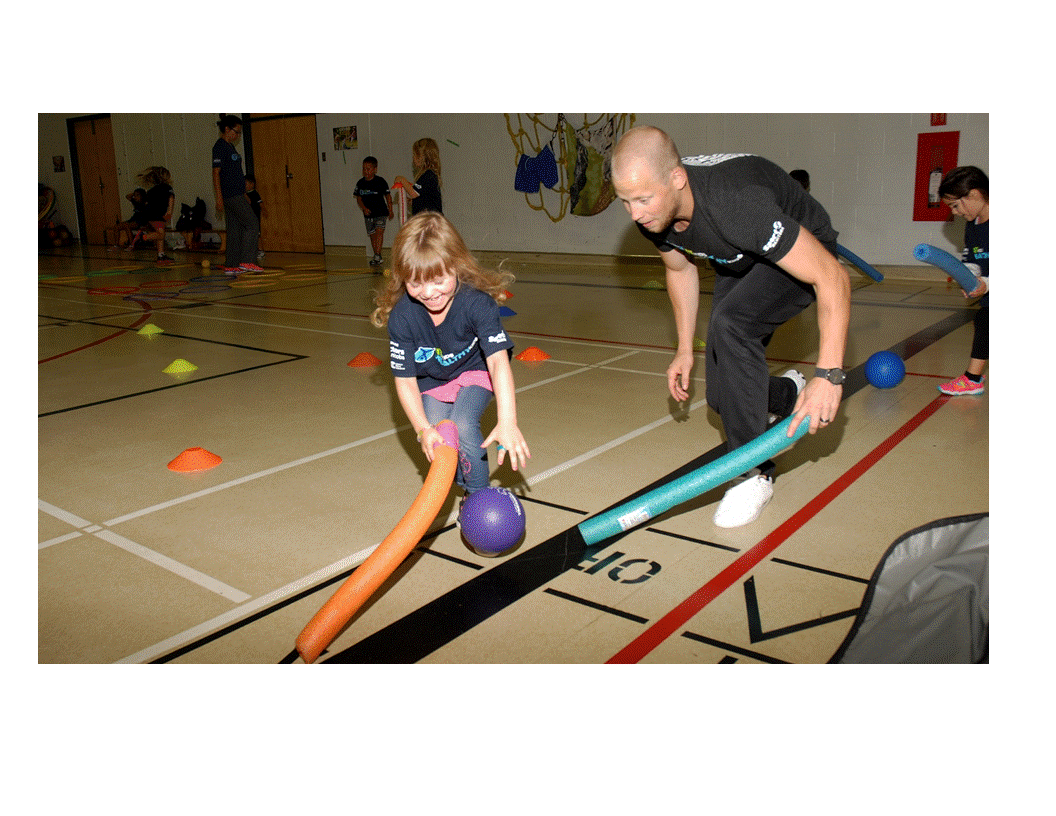It takes an active community to raise an active child.
Let’s work together to put our community’s children on a path to an active for life attitude!

Teachers, early childhood educators, recreation workers, camp counselors, teachers' assistants and coaches are some of the most important people in a child’s life!
With the ability to be role models, leaders,guardians and friends it is key that all of these community members realize how important they are in ensuring that children are getting the physical activity they need on a daily basis.
Children should have at least 60 minutes of adult lead physical activity each day and many more hours of unstructured active play. Everyone needs to work together to ensure that children are receiving quality activity time while children are in their care.
When everyone works together to promote physical literacy and the development of fundamental movement skills we can ensure that every child is building the confidence and competence they need to be successful in recreation, sport and life.
| 20 Tips to Help Kids in Your Care Improve Their Physical Literacy: |
|---|
1. Have a planChildren have short attention spans. What works with one group does not always work with another. Have a list of activities and games that work on a variety of skills. |
2. Have equipment readyScrambling for equipment while the children are there can make things difficult for you and lose the attention of the children. Ensure that you have enough equipment for each child and remember that if you teach games that use little to no equipment children can repeat these games when they are in a less structured environment. |
3. Ensure your group size is manageableRatios of adults to children is important for crowd control and understanding of activities. |
4. Be active and engaged during activity timeYou do not always have to be running the race or playing the game alongside the children. It is important to be actively involved in the session that you are leading. Be a timer, a retriever, a referee, and a cheerleader, children stay engaged in activity longer if adults are encouraging, present and engaged. |
5. Use markings on the floorUsing hoops to start lines, using painters tape to section off areas for stations or create lines to follow, or using cones as borders and end zones is important for keeping the kids organized and the session flowing with ease. |
6. Ensure maximum participationEnsure the games you choose are inclusive and do not have children waiting in long lines for their turn. Lines of 4 or less in fast passed activities can provide maximum participation of all the children during activity time. Games where all the children are playing together or at the same time will keep the children moving for longer periods of time. Get rid of Elimination games where children have to sit out, give them a task to preform to get them back in the game. Ex. If you are tagged you need to do 5 star jumps to get back in the game. |
7. Play non-sport specific/low organized gamesGames that are inclusive, non-threating and non-sport specific this will ensure maximum participation and fun with fitness hidden in the agenda. These games will help to develop fundamental movement skills that will later transfer into fundamental sports skills. Don’t forget to take a holistic approach to activity and include things like dance, martial arts and yoga for variety. When choosing to play a more organized sport make your you adapt the game so that there is more opportunity for everyone to be involved. Ex. Less children per team, more than one ball or puck etc. Check out our collection of games. |
8. Give opportunity for children to play in various environmentson land, in the water, in the air and on ice and snow. |
9. Focus on fundamental movement skillsEnsure that the activities you use focus on fundamental/ basic movement skills like running, galloping, skipping, hopping, jumping, leaping, catching, throwing, tracking, kicking, striking, dodging, rhythm, agility, balance and coordination. Many games and stations will incorporate more than one fundamental movement skill. Get kids working on each skill on both sides of their bodies. Use the proper language and to provide an understanding of each movement skill when working with the children. They should understand the different between a jump a hop and a leap. We have a collection of basic skills and how to teach them here. |
10. Get their Heart rate upWhen deciding what fundamental movement skill to focus on make sure you partner the less active skills like throwing, tracking, kicking etc with more active skills like running, jumping, and skipping. It will keep the children’s attention and ensure that they are increasing their heart rate during activity. |
11. Demonstrate and explain games and skillsAlways take time to demonstrate the skill for the children so they may see it done properly and imitate your movements. If this is not possible then choose a member from the group that has mastered the skill to give a demonstration. |
12. Encourage don’t coachChildren in the Active Start and Fundamental stages of Long Term Athlete development need to learn by doing. Opportunity to practice and repetition of movements are the most important things at this age. Having small pointers, suggestions and teachable moments will help children improve but preforming the skill and imitation of a role model will advance their skills at a much faster rate. |
13. Safety is important but so is riskChildren need an element of risk in play. They need to jump high and climb to help their development. Collisions help children to learn to keep their head up and special awareness. Learning to fall safely is an important part of activity, sport and life. Falling is also considered to be a fundamental movement skill. So don’t let the fear of injury bubble wrap the children in your program control the environment and allow for childhood bumps and bruises. |
14. Take time for water breaksNever deny a child water, ensure you have set aside some time for hydrating and always let a thirsty child drink. |
15. Do not expect children to perform like adultsChildren are learning skills that they have not seen or done before. Give them encouragement even if the skill is not perfect and allow them time to grow and master the skills the group is working on at their own pace. Some will catch on faster than others and some may take longer than most but pressure and frustration will not help a child learn a skill faster than their bodies will allow. Children must learn to move, give them time and support in their process. |
16. Have a soothing cool downBefore moving on to the next activity give the kids an opportunity to do some quite stretching so that they may harness their energy before moving on to a more sedentary task or setting. |
17. Lose your scheduleSometimes this can be difficult or impossible but other times we can let the play go on. If children are activity engaged and there is time let them keep playing, eat lunch a little later, skip the craft and save it for another day and keep the kids moving. |
18. It is not about what you don’t have, it is about what you haveMany games can be played in small spaces with little to no equipment so don’t get stuck on equipment and gyms look at your space and find ways to make it and your equipment work for your group. You may have to toss out rules like no running in the hallways or no jumping off the benches but we can teach children there is a time and a place for these activities in these spaces. Check out our games database for activities that require little or no equipment. |
19. Make it funThis is the most important to keep the children coming back. The experiences they have now during activity will shape their attitudes and emotions towards activity for a life time. Ensure the kids are enjoying themselves it will keep them moving longer and keep them moving when they are no longer in your care. |
20. Don’t be afraidIt all may seem overwhelming but start small, focus on what your space allows, what you feel comfortable with and add things as your program grows. Let your inhibitions about yourself and your ability go. You don’t need to be an athlete to help children get moving. You have to be confident and show them anyone can do it. You have to be silly and make them laugh. You have to realize that they will love the games that you have planned for them. You have to provide opportunities and excitement. So find your inner child, you will be surprised at how you improve right alongside them. Need more help...give us a call! |




